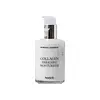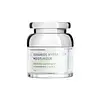What's inside
What's inside
 Key Ingredients
Key Ingredients

 Benefits
Benefits

 Concerns
Concerns

 Ingredients Side-by-side
Ingredients Side-by-side

Water
Skin ConditioningParaffinum Liquidum
EmollientButylene Glycol
HumectantTriethanolamine
BufferingCetearyl Alcohol
Emollient1,2-Hexanediol
Skin ConditioningStearic Acid
CleansingPalmitic Acid
EmollientMoringa Oleifera Seed Oil
EmollientCarbomer
Emulsion StabilisingGlyceryl Stearate
EmollientPEG-100 Stearate
Illicium Verum Fruit Extract
PerfumingGlycerin
HumectantOctyldodecanol
EmollientOleyl Alcohol
EmollientScutellaria Baicalensis Root Extract
AstringentButyrospermum Parkii Butter
Skin ConditioningHydrolyzed Soy Flour
Skin ConditioningCollagen Extract
Skin ConditioningCeramide NP
Skin ConditioningPhytosphingosine
Skin ConditioningHydrogenated Lecithin
EmulsifyingGlycine Soja Sterols
EmollientCandida Bombicola/Glucose/Methyl Rapeseedate Ferment
AntimicrobialTocopherol
AntioxidantBeta-Glucan
Skin ConditioningCentella Asiatica Extract
CleansingParfum
MaskingWater, Paraffinum Liquidum, Butylene Glycol, Triethanolamine, Cetearyl Alcohol, 1,2-Hexanediol, Stearic Acid, Palmitic Acid, Moringa Oleifera Seed Oil, Carbomer, Glyceryl Stearate, PEG-100 Stearate, Illicium Verum Fruit Extract, Glycerin, Octyldodecanol, Oleyl Alcohol, Scutellaria Baicalensis Root Extract, Butyrospermum Parkii Butter, Hydrolyzed Soy Flour, Collagen Extract, Ceramide NP, Phytosphingosine, Hydrogenated Lecithin, Glycine Soja Sterols, Candida Bombicola/Glucose/Methyl Rapeseedate Ferment, Tocopherol, Beta-Glucan, Centella Asiatica Extract, Parfum
Water
Skin ConditioningCyclomethicone
EmollientNiacinamide
SmoothingGlycerin
HumectantButylene Glycol
HumectantPhenoxyethanol
PreservativeAcrylates Copolymer
Triethanolamine
BufferingBrassica Oleracea Italica Sprout Extract
EmollientBrassica Campestris Sprout Extract
HumectantBrassica Oleracea Gemmifera Extract
AstringentHelianthus Annuus Extract
EmollientAmmonium Polyacryloyldimethyl Taurate
Emulsion StabilisingChlorphenesin
AntimicrobialCeramide AP
Skin ConditioningHyaluronic Acid
HumectantHamamelis Virginiana Water
AstringentAllantoin
Skin ConditioningZinc PCA
HumectantBorago Officinalis Leaf Extract
Skin ConditioningParfum
MaskingAlcohol
AntimicrobialT-Butyl Alcohol
PerfumingTetrasodium EDTA
Vitis Vinifera Seed Oil
EmollientRosa Rugosa Flower Oil
MaskingCitrus Paradisi Fruit Extract
Skin ConditioningWater, Cyclomethicone, Niacinamide, Glycerin, Butylene Glycol, Phenoxyethanol, Acrylates Copolymer, Triethanolamine, Brassica Oleracea Italica Sprout Extract, Brassica Campestris Sprout Extract, Brassica Oleracea Gemmifera Extract, Helianthus Annuus Extract, Ammonium Polyacryloyldimethyl Taurate, Chlorphenesin, Ceramide AP, Hyaluronic Acid, Hamamelis Virginiana Water, Allantoin, Zinc PCA, Borago Officinalis Leaf Extract, Parfum, Alcohol, T-Butyl Alcohol, Tetrasodium EDTA, Vitis Vinifera Seed Oil, Rosa Rugosa Flower Oil, Citrus Paradisi Fruit Extract
Ingredients Explained
These ingredients are found in both products.
Ingredients higher up in an ingredient list are typically present in a larger amount.
Butylene Glycol (or BG) is used within cosmetic products for a few different reasons:
Overall, Butylene Glycol is a safe and well-rounded ingredient that works well with other ingredients.
Though this ingredient works well with most skin types, some people with sensitive skin may experience a reaction such as allergic rashes, closed comedones, or itchiness.
Learn more about Butylene GlycolGlycerin is already naturally found in your skin. It helps moisturize and protect your skin.
A study from 2016 found glycerin to be more effective as a humectant than AHAs and hyaluronic acid.
As a humectant, it helps the skin stay hydrated by pulling moisture to your skin. The low molecular weight of glycerin allows it to pull moisture into the deeper layers of your skin.
Hydrated skin improves your skin barrier; Your skin barrier helps protect against irritants and bacteria.
Glycerin has also been found to have antimicrobial and antiviral properties. Due to these properties, glycerin is often used in wound and burn treatments.
In cosmetics, glycerin is usually derived from plants such as soybean or palm. However, it can also be sourced from animals, such as tallow or animal fat.
This ingredient is organic, colorless, odorless, and non-toxic.
Glycerin is the name for this ingredient in American English. British English uses Glycerol/Glycerine.
Learn more about GlycerinParfum is a catch-all term for an ingredient or more that is used to give a scent to products.
Also called "fragrance", this ingredient can be a blend of hundreds of chemicals or plant oils. This means every product with "fragrance" or "parfum" in the ingredients list is a different mixture.
For instance, Habanolide is a proprietary trade name for a specific aroma chemical. When used as a fragrance ingredient in cosmetics, most aroma chemicals fall under the broad labeling category of “FRAGRANCE” or “PARFUM” according to EU and US regulations.
The term 'parfum' or 'fragrance' is not regulated in many countries. In many cases, it is up to the brand to define this term.
For instance, many brands choose to label themselves as "fragrance-free" because they are not using synthetic fragrances. However, their products may still contain ingredients such as essential oils that are considered a fragrance by INCI standards.
One example is Calendula flower extract. Calendula is an essential oil that still imparts a scent or 'fragrance'.
Depending on the blend, the ingredients in the mixture can cause allergies and sensitivities on the skin. Some ingredients that are known EU allergens include linalool and citronellol.
Parfum can also be used to mask or cover an unpleasant scent.
The bottom line is: not all fragrances/parfum/ingredients are created equally. If you are worried about fragrances, we recommend taking a closer look at an ingredient. And of course, we always recommend speaking with a professional.
Learn more about ParfumTriethanolamine is an emulsifier and pH adjuster. It is created using ethylene oxide and ammonia. This gives Triethanolamine a nitrogen core and a similar scent to ammonia.
As an emulsifier, it prevents ingredients from separating and enhances texture by adding volume to a product.
PH adjusters are common in cosmetic products. The pH of a product can affect the effectiveness of other ingredients. A product with a high pH may also irritate the skin.
Learn more about TriethanolamineWater. It's the most common cosmetic ingredient of all. You'll usually see it at the top of ingredient lists, meaning that it makes up the largest part of the product.
So why is it so popular? Water most often acts as a solvent - this means that it helps dissolve other ingredients into the formulation.
You'll also recognize water as that liquid we all need to stay alive. If you see this, drink a glass of water. Stay hydrated!
Learn more about Water